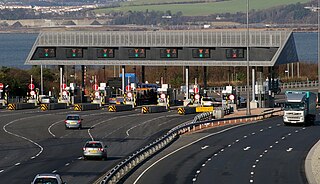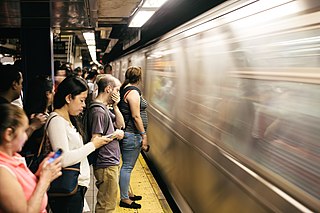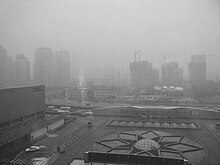
Transport economics is a branch of economics founded in 1959 by American economist John R. Meyer that deals with the allocation of resources within the transport sector. It has strong links to civil engineering. Transport economics differs from some other branches of economics in that the assumption of a spaceless, instantaneous economy does not hold. People and goods flow over networks at certain speeds. Demands peak. Advance ticket purchase is often induced by lower fares. The networks themselves may or may not be competitive. A single trip may require the bundling of services provided by several firms, agencies and modes.

Road pricing are direct charges levied for the use of roads, including road tolls, distance or time-based fees, congestion charges and charges designed to discourage the use of certain classes of vehicle, fuel sources or more polluting vehicles. These charges may be used primarily for revenue generation, usually for road infrastructure financing, or as a transportation demand management tool to reduce peak hour travel and the associated traffic congestion or other social and environmental negative externalities associated with road travel such as air pollution, greenhouse gas emissions, visual intrusion, noise pollution and road traffic collisions.

Congestion pricing or congestion charges is a system of surcharging users of public goods that are subject to congestion through excess demand, such as through higher peak charges for use of bus services, electricity, metros, railways, telephones, and road pricing to reduce traffic congestion; airlines and shipping companies may be charged higher fees for slots at airports and through canals at busy times. Advocates claim this pricing strategy regulates demand, making it possible to manage congestion without increasing supply.

Traffic congestion is a condition in transport that is characterized by slower speeds, longer trip times, and increased vehicular queueing. Traffic congestion on urban road networks has increased substantially since the 1950s. When traffic demand is great enough that the interaction between vehicles slows the traffic stream, this results in congestion. While congestion is a possibility for any mode of transportation, this article will focus on automobile congestion on public roads.

A rush hour or peak hour is a part of the day during which traffic congestion on roads and crowding on public transport is at its highest. Normally, this happens twice every weekday: once in the morning and once in the afternoon or evening, the times during which most people commute. The term is often used for a period of peak congestion that may last for more than one hour.
Vehicle emissions control is the study of reducing the emissions produced by motor vehicles, especially internal combustion engines.

Emission standards are the legal requirements governing air pollutants released into the atmosphere. Emission standards set quantitative limits on the permissible amount of specific air pollutants that may be released from specific sources over specific timeframes. They are generally designed to achieve air quality standards and to protect human life. Different regions and countries have different standards for vehicle emissions.

Exhaust gas or flue gas is emitted as a result of the combustion of fuels such as natural gas, gasoline (petrol), diesel fuel, fuel oil, biodiesel blends, or coal. According to the type of engine, it is discharged into the atmosphere through an exhaust pipe, flue gas stack, or propelling nozzle. It often disperses downwind in a pattern called an exhaust plume.
Vehicle size classes are series of ratings assigned to different segments of automotive vehicles for the purposes of vehicle emissions control and fuel economy calculation. Various methods are used to classify vehicles; in North America, passenger vehicles are classified by total interior capacity while trucks are classified by gross vehicle weight rating (GVWR). Vehicle segments in the European Union use linear measurements to describe size. Asian vehicle classifications are a combination of dimensions and engine displacement.
A low-emission zone (LEZ) is a defined area where access by some polluting vehicles is restricted or deterred with the aim of improving air quality. This may favour vehicles such as bicycles, micromobility vehicles, (certain) alternative fuel vehicles, hybrid electric vehicles, plug-in hybrids, and zero-emission vehicles such as all-electric vehicles.
Hoy No Circula is the name of an environmental program intended to improve the air quality of Mexico City. A similar coordinated program operates within the State of México, which surrounds Mexico City on three sides. Mexico City and Mexico State have reciprocal agreements with surrounding states that also have emissions testing programs to permit their residents to travel freely without restriction.

The automotive industry in China has been the largest in the world measured by automobile unit production since 2008. Since 2009, annual production of automobiles in China accounted for more than 32% of worldwide vehicle production, exceeding both that of the European Union and that of the United States and Japan combined.

Road space rationing, also known as alternate-day travel, driving restriction and no-drive days, is a travel demand management strategy aimed to reduce the negative externalities generated by urban air pollution or peak urban travel demand in excess of available supply or road capacity, through artificially restricting demand by rationing the scarce common good road capacity, especially during the peak periods or during peak pollution events. This objective is achieved by restricting traffic access into an urban cordon area, city center (CBD), or district based upon the last digits of the license number on pre-established days and during certain periods, usually, the peak hours.
Odd–even rationing is a method of rationing in which access to some resource is restricted to some of the population on any given day. In a common example, drivers of private vehicles may be allowed to drive, park, or purchase gasoline on alternating days, according to whether the last digit in their license plate is even or odd. Similarly, during a drought, houses can be restricted from using water outdoors according to the parity of the house number.

In China, the term new energy vehicle (NEV) is used to designate automobiles that are fully or predominantly powered by electric energy, which include plug-in electric vehicles — battery electric vehicles (BEVs) and plug-in hybrid electric vehicles (PHEVs) — and fuel cell electric vehicles (FCEV). The Chinese Government began implementation of its NEV program in 2009 to foster the development and introduction of new energy vehicles, and electric car buyers are eligible for public subsidies.

The 2013 Eastern China smog was a severe air pollution episode that affected East China, including all or parts of the municipalities of Shanghai and Tianjin, and the provinces of Hebei, Shandong, Jiangsu, Anhui, Henan, and Zhejiang, during December 2013. A lack of cold air flow, combined with slow-moving air masses carrying industrial emissions, collected airborne pollutants to form a thick layer of smog over the region. Levels of PM2.5 particulate matter averaged over 150 micrograms per cubic metre; in some areas, they were 300 to 500 micrograms per cubic metre.

APEC blue refers to the rare blue sky in Beijing during APEC China 2014 due to emission reduction campaign directed by Chinese government. Because of its transience, the new phrase "APEC blue" also refers to something wonderful but also fleeting.

Cars affect many people, not just drivers and car passengers. The externalities of automobiles, similarly to other economic externalities, are the measurable difference in costs for other parties to those of the car proprietor, such costs not taken into account when the proprietor opts to drive their car. According to Harvard University, the main externalities of driving are local and global pollution, oil dependence, traffic congestion and traffic collisions; while according to a meta-study conducted by the Delft University these externalities are congestion and scarcity costs, accident costs, air pollution costs, noise costs, climate change costs, costs for nature and landscape, costs for water pollution, costs for soil pollution and costs of energy dependency.
Beijing's License Lottery was implemented in 2011 to address traffic congestion and air pollution in China's capital. The lottery issues new car license plates to residents in order to limit the number of cars on the road.
China's first subway was constructed in Beijing in January 1970, nearly one hundred years after its initial development in London. By 1984, 66 major subway systems existed worldwide. Urban rail transit helped ease the immense pressure caused by urban traffic congestion, while allowing commuters to travel at great speed and convenience. Tianjin was the second city to have an urban rapid transit system and Shanghai was the third, the latter opening its Metro in 1995 that incorporated both subway and light railway lines.

















